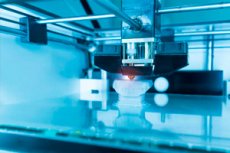3D printing technique makes it possible to make customized pharmaceutical pills
Sist anmeldt: 14.06.2024

Alt iLive-innhold blir gjennomgått med medisin eller faktisk kontrollert for å sikre så mye faktuell nøyaktighet som mulig.
Vi har strenge retningslinjer for innkjøp og kun kobling til anerkjente medieområder, akademiske forskningsinstitusjoner og, når det er mulig, medisinsk peer-evaluerte studier. Merk at tallene i parenteser ([1], [2], etc.) er klikkbare koblinger til disse studiene.
Hvis du føler at noe av innholdet vårt er unøyaktig, utdatert eller ellers tvilsomt, velg det og trykk Ctrl + Enter.

A new 3D drug printing technique has made it possible to print multiple drugs into a single tablet, paving the way for personalized pills that can deliver doses on schedule.
Researchers from the University of Nottingham's Center for Additive Manufacturing, together with the School of Pharmacy, have created personalized medicines using multifunctional inkjet 3D printing (MM-IJ3DP). The study was published in Materials Today Advances.
The team has developed an advanced method that allows the creation of customized pharmaceutical tablets with customized drug release profiles, providing more precise and effective treatment options for patients.
Multifunctional inkjet 3D printing (MM-IJ3DP) can print tablets that release drugs at a controlled rate determined by the tablet design. This is made possible thanks to a new ink formula based on molecules sensitive to ultraviolet light. When printed, these molecules form a water-soluble structure.
The rate of drug release is controlled by the unique internal structure of the tablet, which allows you to set the timing of the dose release. This method makes it possible to print multiple drugs into a single tablet, simplifying complex single-dose drug regimens.
Dr Yingfeng He, assistant professor at the Center for Additive Manufacturing in the Faculty of Engineering, who led the study, said: “This is an exciting step forward in the development of personalized medicines. This breakthrough not only highlights the potential of 3D printing in the drug delivery revolution, but also opens up new avenues for the development of the next generation of personalized medicines.”
"Despite its promise, the technology faces challenges, including the need for more formulations to support a wider range of materials. Ongoing research is aimed at improving these aspects, increasing the potential for MM-IJ3DP to be widely used." - Professor Ricky Wildman
This technology will be especially useful for creating medications that need to release drugs at specific times, making it ideal for treating diseases where precision timing and dosage are important. The ability to print 56 tablets in one batch demonstrates the scalability of this technology, which provides great potential for the production of personalized medicines.
Professor Felicity Rose, from the School of Pharmacy at the University of Nottingham, one of the study's co-authors, said: “The future of prescription medicines lies in a personalized approach and we know that up to 50% of people in the UK do not take their medicines correctly, leading to poor health due to uncontrolled or improperly treated conditions. The single-pill approach will make it easier to take multiple medications at different times, and this study is an exciting step in that direction."
